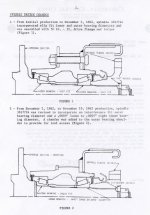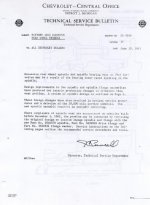Hib Halverson
Technical Writer for Internet & Print Media
Here's a little anecdote which underlines the importance of preventive maintenance.
Way back in the early 90s, I had my rear axle bearings apart to set the bearing clearance at the ideal .0015, rather than the "acceptable" .001-.010. This is done by disassembling each axle and carrier, chucking the axle in a lathe to convert it from a heavy-press fit to a "slip fit" such that you can take the axle out with hand tools. While your at it, if you're really doing things right, press the wheel studs out of the axle then true the wheel mounting flange
Next, I surface-ground a bearing shim such that the axle/bearing/carrier stack has .0015 clearance. Then ordered Timkin bearings and packed them with Red Line CV-2 Synthetic grease and final-assembled each carrier.
They stayed that way for nearly 20 years.
This week, after almost two decades and about 40,000 miles, I disassembled each carrier to inspect the bearings and repack them. There was little or no wear on the bearings. The Red Line CV-2 was not dried out or comtaminated. In fact, the bearings probably could have gone another five years or so.
So, I ordered new inner and outer axle seals from Zip Products, replaced the parking brake shoes with relined stainless shoes from Zip Products, cleaned and repacked the bearings with fresh CV-2 and reassembled each axle/carrier.
Few people observe GM's recommendation of cleaning and repacking the rear bearings ever 36,000 miles or so because of the difficulty in disassembling the carriers the first time, but for those owning C2/3s with disc brakes, if you plan on keeping the car a long time, you're better to convert the bearings to a slip fit then cleaning/repacking the bearings ever so often.
Way back in the early 90s, I had my rear axle bearings apart to set the bearing clearance at the ideal .0015, rather than the "acceptable" .001-.010. This is done by disassembling each axle and carrier, chucking the axle in a lathe to convert it from a heavy-press fit to a "slip fit" such that you can take the axle out with hand tools. While your at it, if you're really doing things right, press the wheel studs out of the axle then true the wheel mounting flange
Next, I surface-ground a bearing shim such that the axle/bearing/carrier stack has .0015 clearance. Then ordered Timkin bearings and packed them with Red Line CV-2 Synthetic grease and final-assembled each carrier.
They stayed that way for nearly 20 years.
This week, after almost two decades and about 40,000 miles, I disassembled each carrier to inspect the bearings and repack them. There was little or no wear on the bearings. The Red Line CV-2 was not dried out or comtaminated. In fact, the bearings probably could have gone another five years or so.
So, I ordered new inner and outer axle seals from Zip Products, replaced the parking brake shoes with relined stainless shoes from Zip Products, cleaned and repacked the bearings with fresh CV-2 and reassembled each axle/carrier.
Few people observe GM's recommendation of cleaning and repacking the rear bearings ever 36,000 miles or so because of the difficulty in disassembling the carriers the first time, but for those owning C2/3s with disc brakes, if you plan on keeping the car a long time, you're better to convert the bearings to a slip fit then cleaning/repacking the bearings ever so often.


 me.
me.







